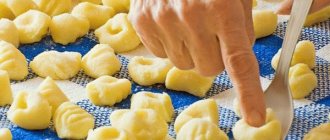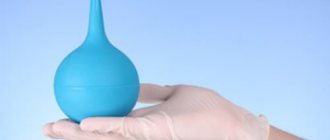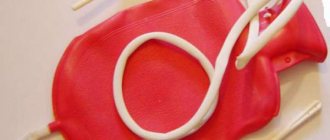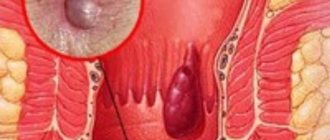General information
If a person constantly experiences constipation , he can use a variety of remedies that modern pharmacology offers. For constipation, both modern medications and folk remedies are widely used. Prebiotics help overcome congestion in the intestines . diet , the use of bulk fillers, etc.
also help However, their effectiveness has not been confirmed by official medicine. However, sometimes none of these methods work as effectively as needed. Then people can resort to another method of bowel movement - an enema. But when doing this, you need to remember that a cleansing enema at home should be carried out taking into account some important rules. You can watch the video or read below how to do such procedures. After all, only if carried out correctly, bowel cleansing enemas for long-term constipation will be effective.
The term “klystyre” is still used in some sources. If you don’t know the word “klystir,” what it is is very easy to understand: this is what some sources call a regular medical enema.
You can’t go anywhere without water: the simplest treatment option
To use an enema for constipation, it is not at all necessary to come up with an unusual medicinal solution. For uncomplicated constipation, regular rinsing with water is sufficient. So, for example, if you give a large enema (over 500 ml) with warm water (22–23 degrees), it will stimulate the lower intestines. If constipation is formed in this part, then intensive excretion of dissolved feces will occur.
To reflexively stimulate peristalsis in the middle sections of the intestine, medium enemas with cold water are done. You need to be careful with this method of treatment at home, since this procedure is contraindicated for spastic constipation (caused by spasms). They are also prohibited from doing during inflammatory processes.
If a person suffers from dyskinetic (neurogenic) constipation, then microenemas can be done with water heated to 35–36 degrees. Procedures with large volumes of water at this temperature cannot be carried out, as this can cause excessive dilation of intestinal vessels.
Is an enema harmful or beneficial?
Wikipedia indicates that there are the following types of enemas:
- medicinal;
- emptying cleansing;
- siphon washing;
- oil;
- hypertensive;
- subaqueous.
However, there is still no consensus on the benefits and harms of such manipulations. Experts express radically opposite opinions when the benefits and harms of such a procedure are discussed. According to some, the benefit of such manipulation is questionable, and the harm is that if you do an enema constantly, it significantly worsens the condition of the intestines. Therefore, such a procedure is advisable only if poisoning has occurred with toxic substances, or surgical intervention or examinations are planned and the intestines need to be cleansed.
The negative effects of such procedures are as follows:
- there is a violation of the pH level in the colon;
- with very frequent enemas, intestinal dysbiosis , since such intervention disrupts the natural microflora ;
- Enema stretches the rectum if done very often, and ultimately leads to weakening of the intestinal muscles and worsening constipation.
After this manipulation, prolonged constipation may occur.
But if an enema for constipation is used only in rare cases, then it is not harmful to the body. In addition, if, due to the operation, the intestines are in a paralytic state, a one-time or several enema is indicated for the person. Also, this procedure is justified in case of poisoning, infections, myocardial infarction - in such cases, this manipulation is recommended by a doctor. He will tell you individually how often this manipulation can be performed on an adult. However, if a colon cleansing enema is carried out for the purpose of intensive cleansing of the body (and there are a lot of such methods now offered), and its use is carried out for a long time, this can cause negative consequences and harm to health. Therefore, under no circumstances should such a procedure be carried out every day.
Mini enemas and their varieties
Mini enemas are done like regular ones. Their volume does not exceed 200 ml, on average – 50-150 ml. They are milder than regular enemas due to their smaller volume, but the effect is no worse, since the concentration of the active substance in them is higher.
Normacol
The mini enema for constipation Normacol with a volume of 130 ml has proven itself well. The composition contains a hypertonic solution that does not irritate the intestines. Stimulation of peristalsis for normal emptying is provided by mechanical stretching. The use of such mini-enemas is effective for the symptomatic treatment of constipation and before diagnostic procedures.
A mini enema is used, just like a regular one. The entire contents of the bottle are administered before bedtime or in the morning. Afterwards you need to lie down until the urge occurs. The maximum single dose for adults is 1 bottle, for children – 60 ml, after 15 years – 130 ml.
Mini enemas cannot be used in the following cases:
- individual intolerance to the drug;
- intestinal obstruction;
- violation of water-salt balance, dehydration;
- cardiac disorders.
For children of different age groups, bottles of different sizes should be used - 60 and 130 ml for children under 3 and under 15 years of age, respectively. During pregnancy, mini enemas are used as prescribed by a doctor, since their safety has not been proven.
Enema Wedge
Enema Clean is a mini enema of 120 ml, which contains sodium dihydrogen phosphate and sodium hydrogen phosphate. This is a saline laxative that promotes the accumulation of fluid in the stool. The effect is very fast - up to 10 minutes.
This mini enema is used not only for constipation. It is indicated before diagnostic procedures and in preparation for surgery.
When inserting, not all the contents of the bottle can be squeezed out, since it contains an extra 15 ml of liquid intended to lubricate the tip.
Contraindications to the use of this drug are hypersensitivity to the composition, acute inflammatory diseases, and intestinal obstruction. The drug is not prescribed for children.
During pregnancy, the use of this drug is not recommended. During gestation, it is better to give preference to glycerin microenemas, as well as enemas with sea buckthorn oil. This also applies to young children.
Adverse reactions include the possibility of nausea, vomiting, and pain in the intestinal area. If unwanted symptoms appear, you should consult a doctor.
Using microenemas with a laxative effect for constipation is a good method of treatment. But you need to remember that this measure is only temporary, and if problems with the intestines occur regularly, you need to seek help from a doctor.
Microclysters are special solutions for rectal use, which are enclosed in a small tube with a long flexible tip. The main advantage is the speed of onset of the effect. It manifests itself within 30 minutes, unlike other groups of laxatives. They are also effective for fecal impaction in the rectum - they soften the mass and promote gentle elimination.
Enema in case of constipation: contraindications
The answer to the question: “If you are constipated, what should you do?” is not always: “Perform an enema.” After all, this method of adjusting bowel movements is emergency and should not become a habit. If you give an enema too often, constipation will only get worse.
Its use is strictly contraindicated in the following cases:
- in the first days after operations performed on the abdominal organs;
- for inflammatory diseases of the rectum of an erosive-ulcerative nature (sigmoiditis, proctitis, colitis ), with cracks, ulcers, erosions;
- for acute ailments of the abdominal cavity: appendicitis , peritonitis;
- if constipation occurs, which provoked hemorrhoids , in case of hemorrhoidal bleeding;
- patients with severe heart failure;
- with rectal prolapse;
- for gastrointestinal and uterine bleeding;
- in case of intestinal tumor;
- if constipation causes pain and there is a suspicion of the development of acute surgical pathology.
It should be noted that during diarrhea, an enema is sometimes given to cleanse the body of toxins , as well as to introduce fluid that is absorbed through the walls of the gastrointestinal tract.
Contraindications and precautions
For adults, the rules are less strict, but regular enema is contraindicated in order to prevent the occurrence of dysbacteriosis and atrophy of the intestinal muscles. Often you can only give an oil enema and only under the supervision of a doctor and as prescribed.
Lack of fluid in the diet is one of the main causes of constipation. To get rid of it in 3 days, you need to drink a simple remedy every day.
The laxative procedure is contraindicated for the following gastrointestinal diseases:
- Peptic ulcer;
- Malignant tumors;
- Erosion;
- Bleeding;
- Acute diseases – peritonitis, appendicitis;
- Postoperative, postpartum conditions;
- Aggravated inflammation of the rectum - colitis, proctitis;
- Heart failure.
Practicing gastroenterologist. Work experience – 9 years in a private clinic. If you haven't found the answer to your question, ask the author!
Homemade enema for constipation
Many people who have problems with bowel movements are interested in how to perform a cleansing enema at home on their own. However, before you do an enema at home for constipation, you need to know the reason for constipation and whether it is a symptom of any disease. It is especially important to determine the cause of chronic constipation before giving yourself an enema with a pear at home. It is imperative to take into account all contraindications, and also clearly understand how to administer an enema correctly in order to obtain the desired effect. You can learn how to do an enema at home correctly from the corresponding video.
But still, the most important thing is to find out the cause of constipation, for which you need to visit a coloproctologist and undergo all the tests that he prescribes.
As a rule, an enema solution at home is administered with a pear. For those who are interested in how to properly give an enema to a child, be sure to choose the right bulb so that it has a soft tip and the appropriate volume.
But problems with stool occur not only in adults, but also in young children. Those who are interested in how to give an enema to a newborn at home should take into account that the baby is given only a cleansing or oil enema. To put it on a baby, you need about 30-35 ml of liquid, for older children - up to 300 ml.
Recipes based on natural oils
For an enhanced effect, you can make special solutions at home that are designed to quickly relieve constipation. An oil enema is prepared based on the following components:
- Castor oil base: 20 ml castor oil per 800 ml warm water. Do 150–200 ml at a time.
- Olive oil base: 80 ml olive oil per 500 ml warm water. Use 150–200 ml at a time.
- Flaxseed oil base: 150 ml of warm linseed oil per 500 ml of cool water. Do 150–200 ml at a time.
- Combined oil base: 30 ml of petroleum jelly, 30 ml of glycerin, 30 ml of enema soap, 60 ml of olive oil - dissolve everything in 400 ml of warm water. Do enemas with this solution several times during the day.
Natural oils have a healing effect, relieve inflammation and promote restoration of the mucous membrane. Such remedies help relieve constipation without harm to the body.
Oils added to the enema solution will help relieve constipation.
Before carrying out the cleaning procedure, it is recommended to prepare a fresh solution. It is better not to use more components than recommended in the recipe. This may cause irritation or an allergic reaction.
Which enema will help with constipation?
If you evaluate the volume of enemas, then they are all divided into large, medium and microenemas.
| Kinds | Volume |
| Microclyster | No more than 100 ml |
| Average | No more than 0.5 liters |
| Big | 1.5-2 liters |
If a person suffers from constipation, then at home a laxative enema is performed in the options described below.
Cleansing
Most often, in order to get rid of constipation, a cleansing enema . It does not affect the tone and receptors of the intestines. Water introduced into the rectum comes out along with the stool.
To do this procedure correctly, you need two liters of boiled water, as well as an Esmarch mug , which can be bought at every pharmacy. This is a rubber heating pad equipped with a thin long hose, at the end of which there is a plastic tip with a clamp.
The heating pad is filled with liquid, then it should be suspended 1 m above the bed. The height of the heating pad makes it possible to control the speed at which the liquid flows. That is, the higher the Esmarch bowl, the faster the water flows. In order for the process to proceed smoothly and correctly, it is advisable that the patient perform the procedure with an assistant.
When the heating pad is empty, the patient needs to lie down for about 15 minutes so that the water penetrates as deeply as possible and softening of the stool occurs and, accordingly, a laxative effect. It is important to maintain this period of time, otherwise stool may remain inside.
If desired, an enema with chamomile or other anti-inflammatory herbs can be performed. You can also introduce the liquid with vinegar by adding 1 tbsp to the liquid. l. 6% apple cider vinegar, which activates intestinal motility.
Hypertensive enema
If a person is prescribed a hypertensive enema , you should know that this is a mini-enema, which is given so that the intestinal receptors act more actively, and he empties himself.
To carry out this procedure, a salt enema is prepared. A saline solution can be prepared from ordinary salt or from those preparations that can be purchased at the pharmacy. These are analogues of salt - bitter salt, Epsom salt, Epsom salt. Their cost is relatively low.
the osmotic pressure in the intestinal lumen increases , since the high concentration solution attracts liquid from nearby tissues. It also softens feces, and salt stimulates peristalsis, irritating the mucous membrane. As a result, emptying occurs quickly - in about 20 minutes.
The solution is easy to prepare: you need 1 tbsp. l. dissolve salts in 100 ml of water. You need to use a rubber bulb into which 50 ml of saline solution is poured.
However, it should be noted that children with constipation cannot undergo this procedure. There is also an opinion that adults should not use such solutions either, as they cause too much irritation.
Oil enema
It is also considered a mini-enema, since the procedure uses no more than 100 ml of oil solution. As a rule, sunflower oil is used for constipation; it can also be olive or Vaseline oil. Sometimes the procedure is carried out with sea buckthorn oil. To make an oil solution, you need to add 2-3 tbsp. l. oil per 100 ml of water. Up to 100 ml of solution must be injected into the rectum, which must be warm for the oil to be effective. The temperature of the oil should be about 37 degrees, for which it is heated in a water bath. How long it takes for an enema to take effect depends on the individual characteristics of the body. But in this case there will be no quick effect: for the oil to take effect, it takes 8-12 hours. Therefore, it is best for both older people and young girls to carry out this procedure before bed.
Microclyster Microlax
Microlax is a solution for rectal administration with a viscous consistency. The product contains sodium lauryl sulfoacetate, sorbitol, sodium citrate. Microlax price – from 360 rubles.
The main advantage of this drug is its rapid action. After about 15 minutes, emptying occurs. In addition, you need to administer a small volume of solution - one tube contains 5 ml of the product, and it is enough for one-time use. The medicine does not have a systemic effect on the body, the microenema does not affect the functioning of the intestines. Therefore, even with regular use of microenemas for constipation, addiction does not develop. Reviews about the use of microenemas for the intestines are mostly positive. The product can be used during pregnancy . True, it is better for pregnant women to initially consult a doctor about using Microlax.
If necessary, a microenema is used for children: children over 3 years old are given a dose of 5 ml; for younger children, the doctor must individually select the dose. The drug is not prescribed to those who have hypersensitivity to the components of the drug. In this case, you can do a chamomile enema at home.
Effective solutions
There are many effective types of solutions for cleaning the intestines, which can quickly get rid of unpleasant symptoms and restore bowel function.
Herbal solution
A solution based on medicinal herbs is considered less aggressive and is allowed for manipulations in children and women during pregnancy. To prepare a herbal decoction you need 2.5 tbsp. l. Add dried chamomile, calendula, plantain, sage or lemon balm to 1 liter of boiling water, cool and strain.
With soda and salt
Enemas with soda and salt for constipation are performed when the use of an oil enema does not bring the expected results. When preparing, use regular table salt or a pharmacy equivalent.
The effect is achieved after half an hour. To prepare, take 15 g of salt and soda and dissolve them in water at a temperature of about 40 °C.
Note! A composition based on soda and salt relieves pain, reduces the acidity of the intestinal environment while simultaneously stimulating peristalsis and clearing accumulated feces.
Oil enema
The use of the drug is recommended when manifest defecation delays are detected. Several types of oils are used to prepare the composition: Vaseline, olive, castor and sunflower are often used.
The oil lubricates the walls of the rectum. Sliding ensures quick but gentle removal of feces. Performing an enema is recommended before bedtime.
Oil preheated to 40 °C is injected into the rectal area by douching. To achieve the effect, after administering the drug, they lie on a trestle bed for ¼ hour, after which they go to have a bowel movement.
Soap solution
Pieces of homemade natural soap
A solution of soap without additives or dyes is used to stimulate intestinal motility.
The recipe has a limitation - it can only be used for temporary defecation disorders. To obtain the composition, dissolve a small piece of natural soap in water.
Medicinal decoction of chamomile
With a mild effect, the composition is effective, cleanses and normalizes intestinal acidity, eliminates bloating and flatulence. To prepare the solution 2 tbsp. l. chamomile, eucalyptus or sage, pour 1 liter of boiling water, leave for an hour and filter.
Microclyster Microlax
The main active ingredients of Microlax microenemas for rectal administration for defecation dysfunction are sorbitol and sodium citrate.
After entering the rectum, the components ensure displacement, liquefaction of feces and their removal from the body. The effect occurs within 5–15 minutes. after using the drug.
Enema for a child with constipation
Before giving a child an enema, it is necessary to determine why stagnation has occurred in the intestines. Often the cause of this condition is intestinal dysbiosis, provoked by the use of antibiotics or due to other reasons. In such a situation, children are prescribed prebiotics or probiotics, which improve the condition of the intestinal microflora.
Particular attention should be paid to nutrition: the baby needs to eat more beets, cabbage, carrots, prunes, and also consume more liquid every day. After consulting with your doctor in advance, you can give your child medicinal herbal decoctions that have a laxative effect.
However, if the baby constantly cries and is capricious because he cannot have a bowel movement, an enema can be used as an emergency method. You can see how to give an enema to a child at home in the corresponding video.
Depending on the age of the child, a certain amount of liquid is taken. So, a baby enema for a newborn or infant should not be more than 50 ml in volume. For children at 2 years old, at 3 years old it is enough to administer 100-200 ml of liquid. If we are talking about how to give a child over 10 years old an enema, its volume can already be 500 ml.
The syringe for administering liquid to a baby should be small, the tip should be soft, and the temperature of the liquid should be about 26 degrees.
It is not advisable to administer concentrated solutions to your child - with soda, soap, salt. It is better to introduce plain water or use vegetable oil with glycerin. Chamomile decoction is also suitable, provided that the baby does not have allergies . As a rule, the effect after the procedure appears after about 10 minutes.
Sometimes infants have problems with stool regularly. How often can such a procedure be performed on a newborn? It is better to ask a pediatrician, who will help determine the causes of frequent constipation and find a way to improve bowel movements.
Recipes based on natural ingredients
The following foods and plants will help cleanse the intestines:
- Beets: pour 20 grams of beets with 2 glasses of water, boil for 30 minutes. Cool the broth to 25 degrees and do the procedure with a medium pear.
- Natural honey: take 10 grams of liquid honey or propolis and dilute in 100 ml of warm water. Do not use if you are allergic to bee waste products.
- Strawberries: a handful of strawberry leaves per 200 ml of boiling water. Let it brew for half an hour. Then strain and heat to 30 degrees. In addition to eliminating constipation, this procedure will strengthen the blood vessels of the intestinal walls, help in the treatment of hemorrhoids and reduce inflammation.
- Medicinal herbs: take 1 tsp. celandine, calendula and chamomile. Pour 500 ml of boiling water and leave for 20–30 minutes. Fill with water to the required volume.
After an enema, which contains natural substances, it is recommended to monitor your condition. If there is no burning or itching, the procedure can be repeated as needed.
A cleansing enema for constipation often helps to quickly normalize bowel movements at home, but is not the only way to eliminate constipation. It is important to do all the tests and find out the cause of intestinal problems and eliminate it, otherwise difficulties with bowel movements will return regularly.
Additional measures to ensure effect
Using a special exercise will help the intestines quickly free themselves from fecal stagnation. The manipulation is carried out before the enema:
- Place your feet shoulder-width apart in a standing position.
- Take a deep breath and then exhale forcefully.
- Next, hold your breath for a few seconds, while you need to tense your abdominal muscles. Then, with an energetic effort, pull the stomach inward so that a depression appears under the ribs.
- Place your hands on your hips, bend your legs slightly and lean your torso forward, but do not bend. This position raises the diaphragm.
- Holding your breath, remain in this position for as long as possible.
- Relax by resuming your breathing and standing up straight on your feet.
Before doing the first enema, when deciding how to get rid of constipation at home, use the exercise 1-2 times, after which it is recommended to increase the range of movements to seven. To ensure good flushing of the gastrointestinal tract with liquid, it is advisable to perform this exercise in different positions: sitting and standing, lying on your back, left side, right side, and also on all fours. To enhance the effect, before starting the exercise, drink several cups of water with salt. Use liquid at room temperature. A proper enema for constipation at home will help restore intestinal functionality.
Rules for administering an enema in the presence of constipation
Knowing and following simple rules will help to give an enema for constipation in adults effectively, safely and painlessly. Before you begin, you need to decide on the type of procedure and prepare an enema solution for constipation in accordance with the recommendations.
| Type of enema | Oily | Hypertensive | Cleansing |
| Required | 50-100ml of heated vegetable oil and a rubber bulb | 100-200 ml 10% sodium chloride or 20-30% magnesia, rubber bulb | 1.5-2 liters of clean water, Esmarch mug |
After this, you should proceed directly to the procedure. There are several stages on how to give an enema for constipation.
- Cover the procedure area with oilcloth so as not to stain it.
- Place the patient on his left side, bending his knees and pulling them towards his stomach.
- For convenience and ease of insertion, lubricate the tip of the bulb with oil or Vaseline.
- Insert the tip with rotational movements into the anus.
- Introduce the solution slowly into the intestines.
- Leave the patient in this position for 15-20 minutes until the urge to defecate appears.
- Leave the oil in the intestinal cavity until the morning.
Why are laxatives used during an enema?
The effect can be enhanced by using laxatives. While an enema cleanses the colon, laxatives cleanse the small intestine. For one-time cleansing, it is good to use magnesium. Approximately forty grams are added to half a liter of warm water and drunk on an empty stomach. After an average of three hours you can expect results. It’s better not to eat anything these days.
It would be a good idea to consult a specialist before any procedure at home. Especially if the question concerns such a delicate problem as constipation. It is necessary to understand that an enema is an emergency measure that should not become a regular way of bowel movement.
What is an enema
An enema is a procedure for introducing liquid into the rectum for the purpose of therapy or diagnosis. Another name for medical manipulation is clyster. If a small amount of liquid is administered (50–200 ml), then this is called a microenema, and the introduction of 1–12 liters of water is considered a macroenema.
A microclyster is intended for the administration of liquids that have a laxative effect, medications, and a macroclyster is prescribed for washing the colon in case of constipation or before preparing for a study or operation. The liquid that is introduced into the intestines helps to soften stool, accelerates their passage, and thanks to the temperature effect it is possible to stimulate peristalsis or relieve spasm of smooth muscles.
The colder the water, the stronger the intestinal wall will contract, therefore, for atonic constipation (when the feces are fragmented, “sheep feces”), cold enemas are given, the temperature of which is up to 12 0C, and for spastic constipation, in order to reduce spasm, fluid administration is indicated 37–39 0C. When administering a medicinal enema, you need to keep the temperature of the liquid at 37–39 0C, so as not to provoke the urge to defecate.
You can add a decoction of chamomile to the liquid (1 spoon per 200 ml of boiling water) or vegetable oil (2 spoons per 1.5 liters of water). Chamomile has an anti-inflammatory and astringent effect, which helps with bloating, and the oil accelerates the elimination of toxins. Apple cider vinegar will enhance intestinal motility (one tablespoon per 1.5 liters of water).
Doctors used to recommend doing a soap enema, but it is now known that soap enema causes severe irritation.
Does an enema have side effects?
In most cases, enemas are safe, but you should be aware of the risks they carry.
Two different published reviews of scientific studies found that there were no convincing benefits associated with the use of enemas to treat constipation, but there were several documented complications and risks.
Reviews have shown that enemas can be useful when health care providers are preparing for a medical examination of your colon and gastrointestinal tract.
This means that if you feel like you need an enema, you should proceed with caution. There are real risks associated with using enemas on a regular basis for constipation.
Electrolyte imbalance
In most enemas, the fluid used is hypertonic, meaning it is saltier than body fluids. Because our blood and body fluids are salty (saline), if you use a saline solution, it can cause dehydration.
Hypertensive enemas draw fluids from the colon and body into the stool and then ultimately out of the body.
In most cases, you can counter this and stay hydrated by drinking enough water when performing an enema, but hypertonic enemas (such as sodium phosphate) are not suitable if you are dehydrated.
On the other hand, regular water enemas are hypotonic (less salty) compared to the body and can cause electrolyte salts such as sodium and potassium to enter the body in the stool, which can lead to electrolyte imbalances.
Disturbs your intestinal flora
Every time you remove stool from your intestines, you disrupt your gut microbiota.
Most of the time, intestinal flora will quickly recover after a cleanse or enema, but frequent enema use can cause more serious disruptions and problems, including infections.
The science linking gut microbes and health is exciting and rapidly evolving. Healthy gut microbiota has been linked to mental health, overall health, bright skin and improved digestion.
addictive
If you regularly use enemas to cleanse your colon, it can lead to addiction, which is harmful to your health.
Whether this creates a physical dependence on the gastrointestinal tract or just a mental need for them, this is not the healthiest solution for regular constipation or for purging.
Rather, a healthy diet, exercise, massage, and supplements may be the best natural approach for the whole body.
Infections
Enemas offered by spas, including colonics, often use shared equipment. If it is not properly cleaned and sterilized, you risk infection.
The same thing can happen with reusable household equipment. Enema use has been linked to proctocolitis, which is an irritation of the lining of the rectum and colon.
You will need to properly sterilize any part of the reusable enema that touches your rectum.
Contraindications
Patients should refuse the procedure:
- those suffering from hemorrhoids, complicated by bleeding and the presence of cracks in the anus and rectum;
- with rectal prolapse;
- in whom performing an enema provokes the appearance of acute pain in the abdominal cavity;
- having benign or malignant neoplasms localized in the large intestine;
- with severe bleeding of any organ of the gastrointestinal tract;
- having ulcerations, erosions and cracks in the intestinal mucous membranes;
- during the period of exacerbation of chronic gastrointestinal diseases.
Enemas for the elderly
Constipation occurs much more often in older people than in younger patients. The occurrence of senile constipation is usually due to:
- developed dysbiosis and specific changes in intestinal microflora;
- hormonal changes that occur during menopause and due to dysfunction of the thyroid gland;
- medications (antidepressants, diuretics and anticholinergic drugs, opiates, antipsychotics) taken in large quantities;
- weakening of the muscles of the pelvis and abdominal wall;
- impaired intestinal motility, fraught with the formation of fecal stones;
- irregular nutrition.
As an emergency aid, they resort to performing enemas, especially relevant for bedridden patients in whom constipation is a consequence of chronic physical inactivity.
To alleviate their condition, you can:
- Perform a cleansing procedure that helps liquefy stool, normalize intestinal microflora and wash out mucus and pus. After heating 100 ml of mineral water to room temperature, take it into a rubber bulb-syringe and inject it into the rectum. The act of defecation usually occurs a few minutes later.
- You can help an immobilized patient get rid of a blockage of fecal stones using a microenema containing a decoction of medicinal herbs. To prepare it, take dried linden leaves, chamomile flowers, stems and leaves of motherwort (fifteen grams each), pour a glass of hot water and boil in a water bath for a quarter of an hour. 100 ml of cooled decoction is injected into the patient’s intestines. A quick effect is achieved due to the softening effect of herbs on stagnant feces .
For elderly people who are not bedridden, in case of constipation, you can do the following:
- A cleansing procedure consisting of introducing a liter of boiled water or chamomile decoction at room temperature into the intestines.
- A medicinal enema, which involves the administration of laxative solutions (microlax or phytomucil preparations), heated to improve absorption to body temperature. Before performing the treatment procedure (about half an hour), it is recommended to do a cleansing enema.
- Hypertonic microenema. This procedure is recommended for patients with a thin build.










